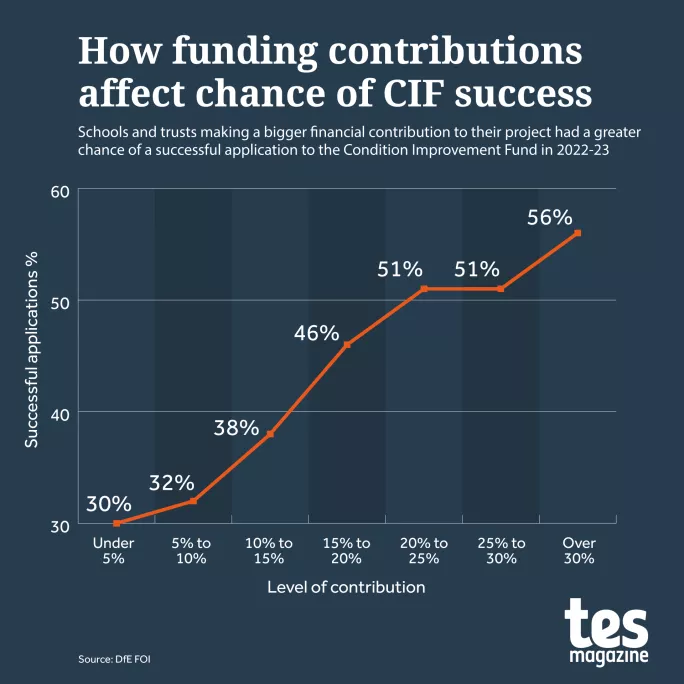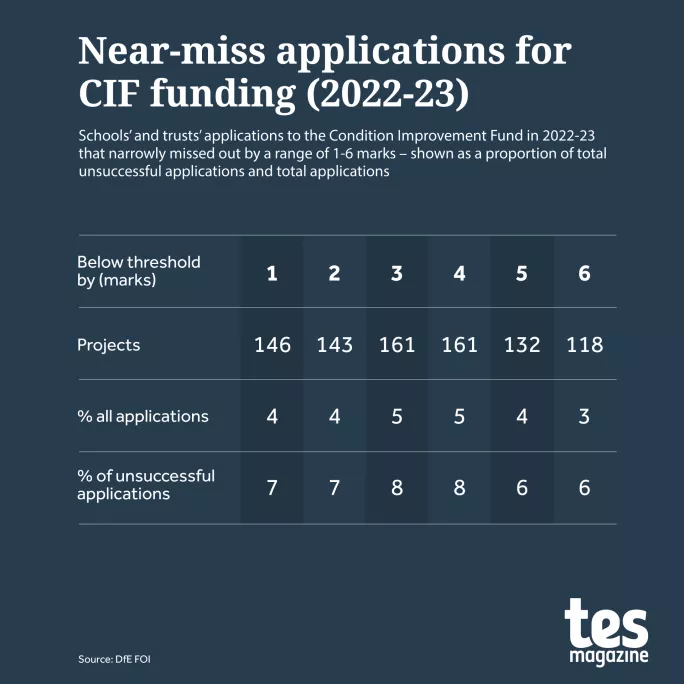Investigation: ‘Vulnerable’ schools miss out on essential repairs cash

Academy trusts are 85 per cent more likely to win government cash to keep school buildings safe if they can stump up large sums themselves, Tes can reveal.
Experts say the findings illustrate how “vulnerable” schools are “disadvantaged” by the bidding process for the Condition Improvement Fund (CIF), which pays for work such as boiler replacements and roof repairs.
This, headteachers warn, risks creating a “vicious cycle of deprivation and decline” because schools with the least resources are often those in most urgent need of repairs.
- School buildings: Half of teachers say school buildings ‘unfit for purpose’
- Funding: The next 50 schools getting rebuilding cash
- Facilities: Why the design of school buildings matters
Smaller academy trusts, as well as some voluntary-aided schools and sixth-form colleges, are eligible to apply to the CIF, which is aimed at funding work to address ”significant condition needs”.
Bids are assessed out of 100, with “project need” accounting for 60 points, “cost” for 25 points and “planning” for 15 points.
Up to six of the 25 available points for “cost” are given to applicants able to make a “significant (and affordable) contribution from other sources or via a CIF loan”, Department for Education (DfE) guidance states. Trusts need to contribute more than 30 per cent of the cost to score the maximum six points.
Analysis by Tes shows how this process has played out this year.

Overall, 56 per cent of trusts that pledged to contribute at least 30 per cent of the total project cost this year were successful, compared with just 30 per cent of those that pledged less than 5 per cent.
This is problematic, according to Pepe Di’Iasio, headteacher at Wales High School in South Yorkshire, because schools in most need of repairs are often those with “the least time and resources available”.
Schools could be left in a “vicious circle of deprivation and decline” as a result of the bidding process, he warned.
And Stephen Morales, chief executive of the Institute of School Business Leadership, said that the way the bidding is set up “disadvantages those more vulnerable settings who probably need it more than anybody”.
The DfE states in its guidance to schools that “the overriding element of any application is project need”, and told Tes in a statement that ”a large majority of the successful projects received half or less of the maximum [six] available points” for their financial contributions.
But, while 62 per cent of successful applications scored between zero and three out of six, only 13 per cent of applications that scored zero were successful, compared with 17 per cent of total applications.
In contrast, 23 per cent of applications that scored six out of six were successful, compared with 17 per cent of total applications.
And, although the DfE has said that the six marks available for funding sources make up “one very small part of a much larger assessment”, competition for the funding means that six points can make a huge difference.
Tim Warneford, a consultant who works on CIF applications for schools, said: “The competition is fierce…Six marks very, very often make all the difference between a successful bid and an unsuccessful one.”
Overall, 1,447 of the 3,501 applications made to CIF in the 2022-23 bidding round were successful.
Mr Warneford said the Tes analysis appeared to confirm a “long-held suspicion” that the CIF application process “heavily favours those who contribute more”.
And he thought schools and trusts with more financial clout had a “big edge” over others this year, as a result of most schools not having spare cash in their coffers.
Schools were awarded a funding boost in this year’s Autumn Statement, but the money will not kick in until next year and sector leaders have warned that schools will still have to “weather the storm” of paying for higher-than-expected pay rises, and larger-than-typical energy costs this year, limiting their budgets.
DfE urged to ‘look again’ at bidding system
Leora Cruddas, chief executive of the Confederation of School Trusts, said it was “very concerning” that a trust’s capacity to make a financial contribution was leading to some missing out on funding.
She added: “We urge the DfE to look again at this requirement…Schools must be safe and it is wrong if this policy is leading to urgent significant needs not being met.”
Julia Harnden, funding specialist at the Association of School and College Leaders, agreed that the ability of schools and trusts to contribute towards the funding of a capital project “should not be a determining factor”.
She said doing so makes it “more difficult for schools and trusts that face the greatest financial challenges to access funding for repairs and maintenance, and risks creating an inequitable situation in which material improvements to schools may be denied to some pupils and communities”.

Funding became a larger factor in bids last year
Prior to last year’s funding round, the funding sources element of CIF bids was worth just five points rather than six.
Top marks could also be achieved with a contribution of more than 10 per cent of the project cost, if the project had a value of over £1 million, with a contribution of over 25 per cent needed to score full marks on the cheapest projects.
But the system was overhauled last year as new guidance said all applicants would have to pay at least 30 per cent of the cost to achieve a maximum of six marks.
Applicants can also part-fund their projects via CIF loans, though the rate of these has increased steeply this year, leading some trust leaders to warn that the “wealthiest schools and trusts are likely to be most successful with CIF bids instead of those that need the investment most”.
A DfE spokesperson called Tes’ analysis “an oversimplification” and said it was “misleading to suggest that a higher funding contribution significantly increases the likelihood of an application’s success when it is one very small part of a much larger assessment”.
“There is no obligation on schools to make a contribution and a large majority of the successful projects received half or less of the maximum available points for the ‘funding sources’ score,” they added.
“Applications to the fund are carefully assessed on condition need, the quality of the project plan and value for money to prioritise the most urgent works.”
Schools are set to be given a share of £500 million capital cash this month, earmarked for making energy efficiency upgrades.
You need a Tes subscription to read this article
Subscribe now to read this article and get other subscriber-only content:
- Unlimited access to all Tes magazine content
- Exclusive subscriber-only stories
- Award-winning email newsletters
Already a subscriber? Log in
You need a subscription to read this article
Subscribe now to read this article and get other subscriber-only content, including:
- Unlimited access to all Tes magazine content
- Exclusive subscriber-only stories
- Award-winning email newsletters
topics in this article



